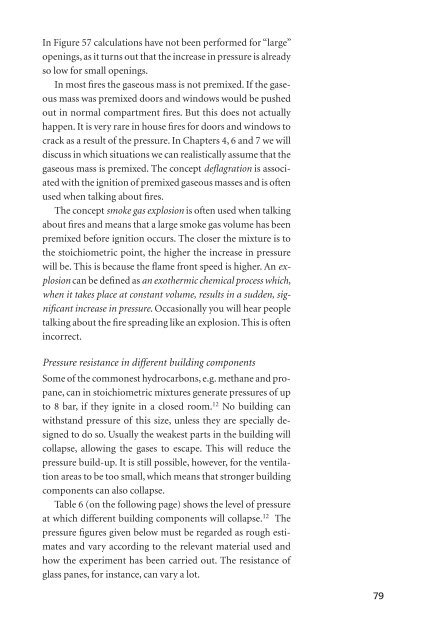You also want an ePaper? Increase the reach of your titles
YUMPU automatically turns print PDFs into web optimized ePapers that Google loves.
In Figure 57 calculations have not been performed for “large”<br />
openings, as it turns out that the increase in pressure is already<br />
so low for small openings.<br />
In most fi res the gaseous mass is not premixed. If the gaseous<br />
mass was premixed doors and windows would be pushed<br />
out in normal compartment fi res. But this does not actually<br />
happen. It is very rare in house fi res for doors and windows to<br />
crack as a result of the pressure. In Chapters 4, 6 and 7 we will<br />
discuss in which situations we can realistically assume that the<br />
gaseous mass is premixed. The concept defl agration is associated<br />
with the ignition of premixed gaseous masses and is often<br />
used when talking about fi res.<br />
The concept smoke gas explosion is often used when talking<br />
about fi res and means that a large smoke gas volume has been<br />
premixed before ignition occurs. The closer the mixture is to<br />
the stoichiometric point, the higher the increase in pressure<br />
will be. This is because the fl ame front speed is higher. An explosion<br />
can be defi ned as an exothermic chemical process which,<br />
when it takes place at constant volume, results in a sudden, signifi<br />
cant increase in pressure. Occasionally you will hear people<br />
talking about the fi re spreading like an explosion. This is often<br />
incorrect.<br />
Pressure resistance in different building components<br />
Some of the commonest hydrocarbons, e.g. methane and propane,<br />
can in stoichiometric mixtures generate pressures of up<br />
to 8 bar, if they ignite in a closed room. 12 No building can<br />
withstand pressure of this size, unless they are specially designed<br />
to do so. Usually the weakest parts in the building will<br />
collapse, allowing the gases to escape. This will reduce the<br />
pressure build-up. It is still possible, however, for the ventilation<br />
areas to be too small, which means that stronger building<br />
components can also collapse.<br />
Table 6 (on the following page) shows the level of pressure<br />
at which different building components will collapse. 12 The<br />
pressure fi gures given below must be regarded as rough estimates<br />
and vary according to the relevant material used and<br />
how the experiment has been carried out. The resistance of<br />
glass panes, for instance, can vary a lot.<br />
79

















